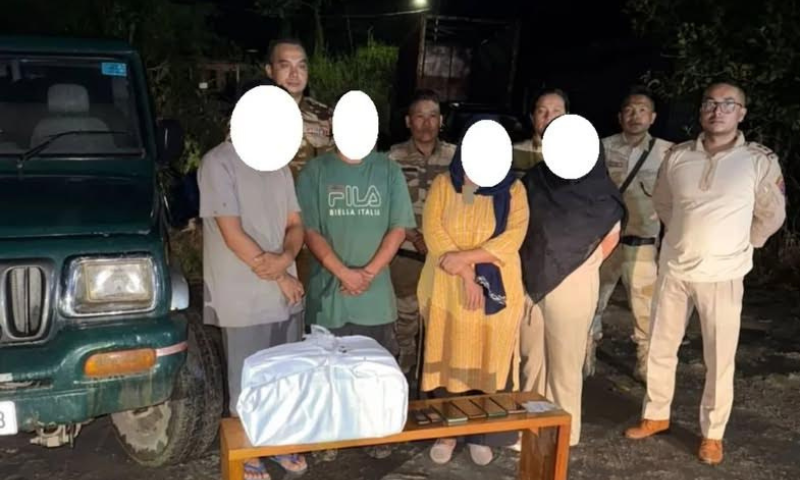Manipur Police Seize Heroin Worth ₹2 Crore, Arrest 3 Smugglers
In a joint operation near Wabagai Lamkhai Thongkha under Kakching Police Station (Kakching district), Manipur’s Narcotics & Affairs of Border (NAB) and local police intercepted a light‑green Bolero, seized 91 “soap cases” packed with suspected heroin (about 1.12 kg, excluding packaging), and arrested three suspects, including a woman. Officers say the consignment was smuggled from Myanmar via Chandel, with a street value estimated around ₹2 crore. The arrests occurred on Wednesday (August 20, 2025) and were reported on Thursday (August 21, 2025); the case proceeds under the NDPS (Amendment) Act, 2023.
Manipur sits on the northeastern edge of India, with porous, mountainous corridors that abut Myanmar—one of Asia’s major narcotics production zones. That geography makes Kakching, Chandel, Tengnoupal, and the trade gateway of Moreh crucial waypoints for traffickers moving heroin and meth into India. Against that backdrop, a ₹2‑crore heroin seizure and the arrest of three alleged smugglers is more than a routine headline; it’s a snapshot of the frontline reality in India’s long fight against narcotics flowing westward from Myanmar.
The Operation: What Exactly Happened
Acting on a specific tip, a joint NAB–civil police team took up positions along a state highway in Kakching district. When a light green Bolero believed to be ferrying contraband rolled into view, officers flagged it down and conducted a search. Inside, they discovered 91 soap cases, a packaging method favored by traffickers for its compactness and concealability. The net weight of the powder (excluding packaging) came to roughly 1.12 kg—a quantity that crosses the threshold for serious charges under India’s anti‑narcotics law. Besides the suspected heroin, the team seized five mobile phones and two Aadhaar cards, which can prove valuable for mapping the suspects’ network.
Who was arrested? Police identified the three detainees as Thinmai Kaisidindou Liangmei (53) of Taban village, Tamenglong district; Lunghipuiliu (37) of Kawalong, Tamenglong; and Nanathongliu (42) of Makui, Kangpokpi. All three, along with the seized narcotics and the Bolero, were handed over to the jurisdictional police station for proceedings under the NDPS (Amendment) Act, 2023.
Follow the Trail: The Myanmar–Manipur Route
If you look at a map, the Chandel–Moreh corridor forms a natural funnel from Myanmar into Manipur. This route has historically facilitated licit border trade—but also illicit flows of heroin (“No. 4”) and meth pills. The terrain is rugged, the road network is improving but still patchy, and the border is long and difficult to fully secure, giving organized traffickers room to improvise with side roads and local guides. Analysts and policy research groups have repeatedly flagged Moreh and nearby corridors as critical transit points where consignments are broken up, repackaged, and pushed further into the Indian mainland.
“Soap Cases”
Why do so many northeastern drug busts involve soap cases? Because they’re compact, stackable, and easy to hide in door panels, spare‑wheel wells, or false compartments. A “soap case” may only carry a small quantity—tens of grams—but 91 cases add up quickly. The packaging also complicates detection: at a glance, the boxes look mundane and low‑value. Yet across recent operations in Manipur and adjoining Assam, police have repeatedly recovered dozens to hundreds of such cases in a single vehicle stop.
FAQs
1) How much heroin did the police actually seize in Kakching?
About 1.12 kg (excluding packaging) in 91 soap cases, according to Manipur Police, with a street‑value estimate of ~₹2 crore.
2) Why are “soap cases” used so often by traffickers?
They’re small, ordinary‑looking, and easy to hide in vehicle compartments. Bundling dozens of them lets traffickers scale quantity while keeping each unit low‑profile.
3) What law applies to this case?
The case proceeds under India’s NDPS Act, with 2023 amendments guiding enforcement around commercial quantities, asset tracing, and procedural standards.
4) Is Kakching a known hotspot?
Kakching sits between border‑facing Chandel and Imphal’s urban market, making it a logical interdiction zone. The wider Myanmar–Manipur corridor is well‑documented in policy research and law‑enforcement briefs.
5) Are such seizures becoming more frequent in the Northeast?
Recent reports show multiple sizeable busts across Manipur and neighboring Assam, suggesting sustained interdiction pressure and adaptive trafficking.


